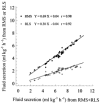Hypertonic fluids are secreted by medial and lateral segments in duck (Anas platyrhynchos) nasal salt glands
- PMID: 11986388
- PMCID: PMC2290278
- DOI: 10.1113/jphysiol.2001.016980
Hypertonic fluids are secreted by medial and lateral segments in duck (Anas platyrhynchos) nasal salt glands
Abstract
Indwelling catheters were used to collect fluid directly from the medial and lateral segments of duck nasal salt glands showing, for the first time, that the secretions are fully hypertonic before reaching the medial and lateral drainage ducts. Using this method it was possible to show that (a) there is a functional symmetry between the left and right salt glands, (b) the medial segment always secretes fluid at approximately twice the rate of the lateral segment and (c) fluid secreted by the medial segment has the same ionic composition but variable ion concentrations when compared with fluid from the lateral segment. A 12 % increase in post-segmental fluid osmolality was probably due to the evaporation of water from epithelial surfaces in the nasal cavities during breathing. A post-segmental outflux of Ca(2+), Mg(2+) and Cl(-) in the medial and lateral collecting ducts and/or nasal epithelium may be of adaptive significance when birds inhabit calcium- and magnesium-rich marine environments.
Figures




References
-
- Butler DG. Endocrine control of the nasal salt glands in birds. Journal of Experimental Zoology. 1984;232:725–736. - PubMed
-
- Butler DG. Adrenalectomy blocks the circulatory and secretory responses by duck nasal salt glands to a hypertonic saline load. Comparative Biochemistry and Physiology. 1985;81:487–490.
-
- Butler DG. Adrenalectomy fails to block salt gland secretion in Pekin ducks (Anas platyrhynchos) adapted to 0. 9 % saline drinking water. General and Comparative Endocrinology. 1987;66:171–181. - PubMed
-
- Butler DG, Siwanowicz H, Puskas D. A re-evaluation of experimental evidence for the hormonal control of avian nasal salt glands. In: Chadwick A, Hughes M, editors. Progress in Avian Osmoregulation. Leeds, UK: The Leeds Philosophical Society; 1989. pp. 127–141.
-
- Butler DG, Youson JH, Campolin E. Configuration of the medial and lateral segments of duck (Anas platyrhynchos) salt glands. Journal of Morphology. 1991;207:201–210. - PubMed
Publication types
MeSH terms
Substances
LinkOut - more resources
Full Text Sources
Miscellaneous

